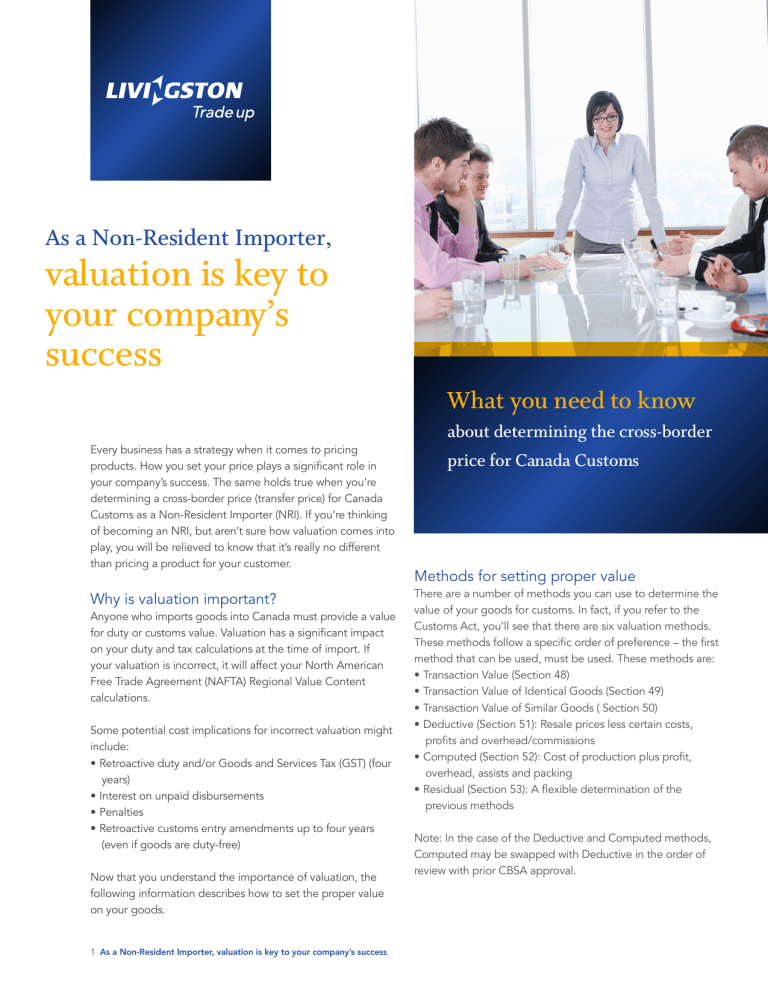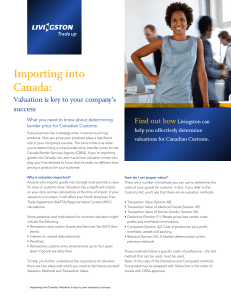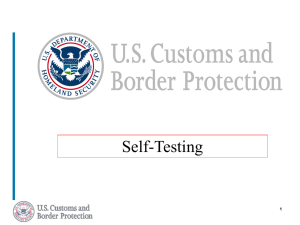valuation is key to your company’s success What you need to know

As a Non-Resident Importer,
valuation is key to your company’s success
Every business has a strategy when it comes to pricing products. How you set your price plays a significant role in your company’s success. The same holds true when you’re determining a cross-border price (transfer price) for Canada
Customs as a Non-Resident Importer (NRI). If you’re thinking of becoming an NRI, but aren’t sure how valuation comes into play, you will be relieved to know that it’s really no different than pricing a product for your customer.
Why is valuation important?
Anyone who imports goods into Canada must provide a value for duty or customs value. Valuation has a significant impact on your duty and tax calculations at the time of import. If your valuation is incorrect, it will affect your North American
Free Trade Agreement (NAFTA) Regional Value Content calculations.
Some potential cost implications for incorrect valuation might include:
• Retroactive duty and/or Goods and Services Tax (GST) (four years)
• Interest on unpaid disbursements
• Penalties
• Retroactive customs entry amendments up to four years
(even if goods are duty-free)
Now that you understand the importance of valuation, the following information describes how to set the proper value on your goods.
What you need to know
about determining the cross-border price for Canada Customs
Methods for setting proper value
There are a number of methods you can use to determine the value of your goods for customs. In fact, if you refer to the
Customs Act, you’ll see that there are six valuation methods.
These methods follow a specific order of preference – the first method that can be used, must be used. These methods are:
• Transaction Value (Section 48)
• Transaction Value of Identical Goods (Section 49)
• Transaction Value of Similar Goods ( Section 50)
• Deductive (Section 51): Resale prices less certain costs, profits and overhead/commissions
• Computed (Section 52): Cost of production plus profit, overhead, assists and packing
• Residual (Section 53): A flexible determination of the previous methods
Note: In the case of the Deductive and Computed methods,
Computed may be swapped with Deductive in the order of review with prior CBSA approval.
1 As a Non-Resident Importer, valuation is key to your company’s success
Transaction Value
Transaction Value is the most common method used. This is the price paid, or payable, when goods are sold for export.
This value will be adjusted based on a number of additions and deductions.
Examples of additions:
• Certain royalties and license fees paid as a condition of the sale for export
• Assists (i.e. materials and equipment provided free of charge to a foreign manufacturer)
• Certain design costs (those incurred outside the country of import)
• Subsequent proceeds tied directly to the sale for export
• Selling commissions (buying commissions are excluded)
• Inland freight to the place of direct shipment
• Packing costs
Examples of deductions:
• International freight from the place of direct shipment to
Canada
• Prompt payment discounts (price reductions arising after import are excluded)
• Duties and taxes paid on import into Canada
• Construction, erection, and/or assembly of machinery in
Canada
Similarly, the method won’t work for any related-party sales at an artificial or arbitrarily set price. Finally, if you have goods where the final price can’t be determined at the time of import, you’ll have to choose a different method.
While there are many other instances when Transaction Value won’t work, these are some of the more common occurrences.
What to consider in valuing your goods
As an NRI, you should consider the following when valuing your goods:
• Related-party transactions. Pricing for taxation may not be the same as pricing for customs. Different guidelines and legislation can result in different additions, deductions and definitions of price.
• Drop shipments. Goods sold from one party, but shipped to Canada by a third party, must follow the Purchaser in
Canada rules.
• Management fees. Certain fees for services performed by a non-resident parent and billed to the Canadian subsidiary must be added to the customs value.
• Freight. Only exact freight amounts substantiated by actual invoices can be deducted. Estimates or freight allowances are not considered to be a valid deduction.
• Assists. These are materials, plans or tools supplied to the vendor/manufacturer to produce the products, and must be added.
• Subsequent proceeds. Proceeds that are a condition of the sale, but happen after the import, form a part of the price paid or payable.
When does the Transaction Value method not work?
There are a number of instances when the Transaction Value method isn’t applicable. For instance, when there’s no sale for export; if you have leased goods, goods that are being warehoused, or goods on consignment the transaction value doesn’t apply. This method also can’t be applied to goods for warranty repair or replacement, or goods used as commercial samples.
For most companies this is a simple exercise, but if you’re considering becoming an NRI you will want to make sure that you have it right. Consult with a customs broker who has experience and expertise in valuation.
Contact your Livingston account executive e-mail us at solutions@livingstonintl.com
or give us a call at 1-800-837-1063
Visit www.livingstonintl.com
2 As a Non-Resident Importer, valuation is key to your company’s success






